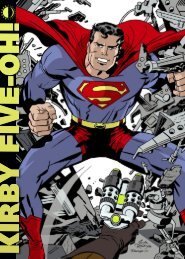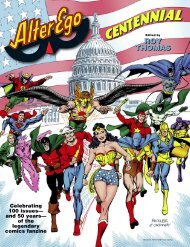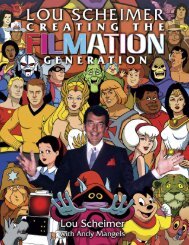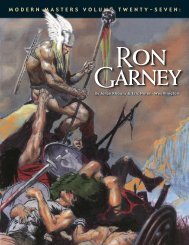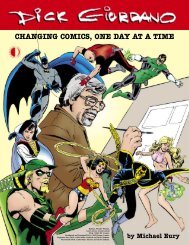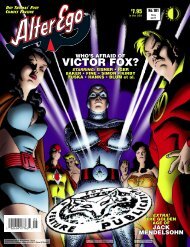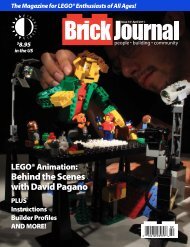Preview - TwoMorrows
Preview - TwoMorrows
Preview - TwoMorrows
Create successful ePaper yourself
Turn your PDF publications into a flip-book with our unique Google optimized e-Paper software.
TM & ©2012 Marvel Characters, Inc.<br />
Stan’s favorite inker for a time was Giacoia. My sense from<br />
interviewing most of these guys over the years is that he was also the<br />
favorite of the pencilers... the guy they were happiest to have inking<br />
their work. Later when Joe Sinnott was lured back with a page rate<br />
increase, Sinnott and Giacoia were the two guys who got all the ink<br />
work they could handle. They were the two guys Stan and Sol (Sol<br />
had some say in this) felt could ink any penciler and any strip,<br />
though there were certain strips they liked having them on—Sinnott<br />
on Fantastic Four, for example.<br />
When they had the “split” books—Tales of Suspense, Tales to<br />
Astonish and Strange Tales—Giacoia was more likely to be assigned<br />
to stories in them. Frank, though a tremendous talent and a very<br />
nice man, had occasional deadline problems. When it was possible,<br />
Stan preferred to assign him to the 10-page stories in books like that<br />
as opposed to the 20-page stories in other titles.<br />
(One thing I always found interesting is that like some other<br />
inkers, Frank often called on friends to help him with jobs when he<br />
was behind. His run inking Gene Colan on Daredevil has a lot of that<br />
with whole pages inked largely by others, though it looks like Frank<br />
(top) Kirby in the Marvel offices in the mid-1960s. Courtesy of the Jack Kirby Museum (www.kirbymuseum.org).<br />
(above) Tales of Suspense #77 splash (May 1966). Frank “Ray” Giacoia even seems to<br />
downplay his brush-heavy style here, perhaps to make it less recognizeable to DC Comics.<br />
8<br />
did some work on every page, especially when rendering the title<br />
character. Those issues are full of help from Mike Peppe, Joe Giella,<br />
Mike Esposito and others and he did this on most jobs he did for<br />
Marvel. The big exception is when he inked Kirby. He<br />
almost never let anyone touch Jack’s pages. Fantastic Four<br />
#39 where Wally Wood inked the Daredevil figures is not<br />
an exception to this since it was Stan who enlisted Wally,<br />
not Frank.)<br />
So Stan would try to steer FF to Sinnott, which would<br />
usually be no problem since Jack was prolific and the<br />
book was usually well ahead of schedule. If Joe had time<br />
to ink something else, they’d give him something else to<br />
ink, but for much of the sixties, Joe was also inking for<br />
Archie and doing work for Treasure Chest so some months,<br />
it was all he could do to squeeze in Fantastic Four.<br />
And Colletta would get Thor which, being Kirby,<br />
was usually ahead so it could wait until Vince had time to<br />
get to it. And there were a few other books with preferred<br />
inkers but basically, it was a question of who needed<br />
work at the right moment.<br />
If you look carefully at the credits of Marvel comics<br />
in the sixties, you may notice that the inker’s name is<br />
often not lettered by the same person who lettered the<br />
rest of the names there. Sometimes, the spacing is a dead<br />
giveaway that they hadn’t designed the credit box for a<br />
name that short or that long.<br />
That means that when the credits were lettered—<br />
probably but a matter of days before the job was given to<br />
an inker—they didn’t know who that inker would be.<br />
They either expected it would be someone else and had<br />
that name lettered in there and later had to change it...<br />
or they didn’t have anyone in mind so they left it blank<br />
and filled it in later.<br />
If you’re curious as to whether this way of doling out<br />
jobs meant that Stan ever had to give a job to someone<br />
he didn’t think would do a great job, the answer is yes.<br />
Many times. There were two factors at work there.<br />
One was a simple matter of deadlines. You have an<br />
issue of something sitting there in pencil. If it’s going to<br />
get to press on time, it’s going to have to be inked in the<br />
next two weeks. Ideally, you’d like Inker A or Inker B or<br />
Inker C but they’re all tied up and unavailable. So you<br />
settle for Inker W. Everyone who ever edits any significant<br />
number of comics occasionally has to settle for<br />
Inker W or Letterer Y.<br />
The other factor was keeping people working. This<br />
was especially a concern in comics back in the era where<br />
the Talent Pool was all guys who’d grown up in the Great<br />
Depression (the one in 1929, not the current one) and



